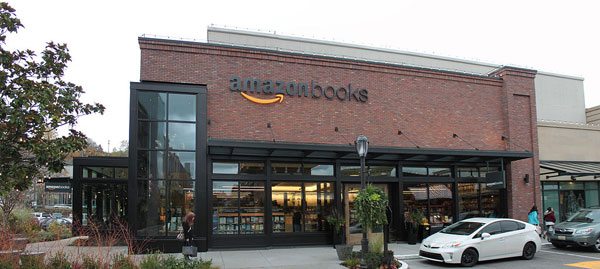
Cities across the country may be competing for the prize of being Amazon’s second headquarters city, better known as HQ2, but Seattle, home of “HQ1,” is less than enthusiastic about the company.
“Seattle is experiencing some serious growing pains, and many longtime residents blame Amazon for forcing their town to grow up too fast,” writes Monica Nickelsburg for GeekWire. “The company has become emblematic of the challenges associated with boom times, from an unforgiving housing market to skyrocketing cost of living to hellish traffic.”
Here at NPQ, we have covered the ongoing saga of the bidding war that Amazon has encouraged among 238 cities vying to be chosen as Amazon’s second headquarters city. We have observed that the economic development dollars being thrown at Amazon might be better directed to support homegrown alternatives, such as employee ownership. We have noted why “social justice base-building” and having civic infrastructure in place are critical if residents in the city selected are to benefit. We have also noted how Amazon’s philanthropic stinginess soured Seattle on Amazon well before the company decided to seek a second headquarters city.
Certainly, Amazon’s failure until recently to contribute to local causes in Seattle did not endear it to residents. But anger in Seattle runs much deeper than that. “In Seattle, much of the Amazon bashing has to do with the rate at which the company has grown,” notes Nickelsburg. A decade ago, Amazon workers in Seattle only occupied five buildings. “Today, the company employs 40,000 in Seattle alone…and takes up 8 million square feet of office space across 33 buildings, in the heart of the city.” This is part of broader company growth: Nationally, employment at Amazon has increased from 30,000 in 2011 to 540,000 globally today, a mere six years later.
One area where Amazon has touched the lives of Seattle residents has been to help drive up real estate prices. Seattle’s median home price, according to Zillow, has jumped from $351,000 in 2012 to $697,700 today. Population has also climbed from 609,000 in 2010 to 704,000 in 2016. The City, according to the Seattle Times, is now the fastest-growing city in the country.
At some level, of course, cities crave growth, which is why 238 proposals were submitted to house Amazon’s second headquarters and why, albeit perhaps misguidedly, cities are willing to throw billions at a company headed by the world’s wealthiest billionaire. But, as Seattle Mayor Tim Burgess warns, the “lucky winner” should be well aware of the downsides that are likely to ensue. Speaking at a forum less than two weeks ago, Burgess said:
Sign up for our free newsletters
Subscribe to NPQ's newsletters to have our top stories delivered directly to your inbox.
By signing up, you agree to our privacy policy and terms of use, and to receive messages from NPQ and our partners.
I would say to those other cities, it’s great if you win Amazon’s second headquarters, but make sure you’re prepared to address the downsides of that. And the downsides are going to affect people who are traditionally marginalized anyway—or already—in our system. People living in poverty, people of color, immigrants and refugees. There are specific things you can do to help mitigate that. Maybe you can’t eliminate it in, just getting one company to come to your city, but you can start doing things to mitigate against that. I wish we had done that sooner in Seattle.
After the fact, Nicholson writes, “Mayor Tim Burgess reflected on policies, like the Mandatory Affordable Housing program, that Seattle has enacted to try to catch up to the tech-driven boom. Burgess similarly responded that ‘I wish we had done that sooner.’”
Burbank, founder of the Economic Opportunity Institute, a Seattle-based, left-of-center think tank, writes that, “While [Amazon] has led to an economic boom in Seattle, that boom has primarily benefitted tech workers at the top and left everyone else with higher rents, higher property taxes, traffic congestion and a bitter taste in our mouths. Amazon has been a sociopathic roommate, sucking up our resources and refusing to participate in daily upkeep.”
A few cities have taken notice. Last month, San Antonio, Texas, published an open letter to Amazon, explaining their decision to not bid for HQ2 and instead focus on what Good Jobs First’s Greg LeRoy called “investments they’ve made in San Antonio’s future: in pre-K education, affordable housing, clean water, the nation’s largest municipal electric utility, climate action planning, bike and running trails, a cybersecurity cluster, and a stable fiscal base that makes it the largest U.S. city with a triple-A credit rating.”
In a similar vein, Mayor Sam Liccardo of San Jose, California, penned a Wall Street Journal op-ed titled “Why I am Not Bidding for Amazon’s HQ,” in which he observed that, “With many subsidies, the jobs a company brings to an area don’t generate revenues commensurate with public expenditures.” In the end, San Jose did submit a proposal, but offered no tax incentives.
In Seattle, Amazon’s growth took the city largely unawares. This can hardly be said of whoever gets to host Amazon’s HQ2. As Nicholson observes, only time will tell if the city selected will act in advance to forestall some of the negative impacts that Amazon has had in Seattle. Alas, the mindless stunts of some cities submitting bids does not provide much cause for optimism.—Steve Dubb












